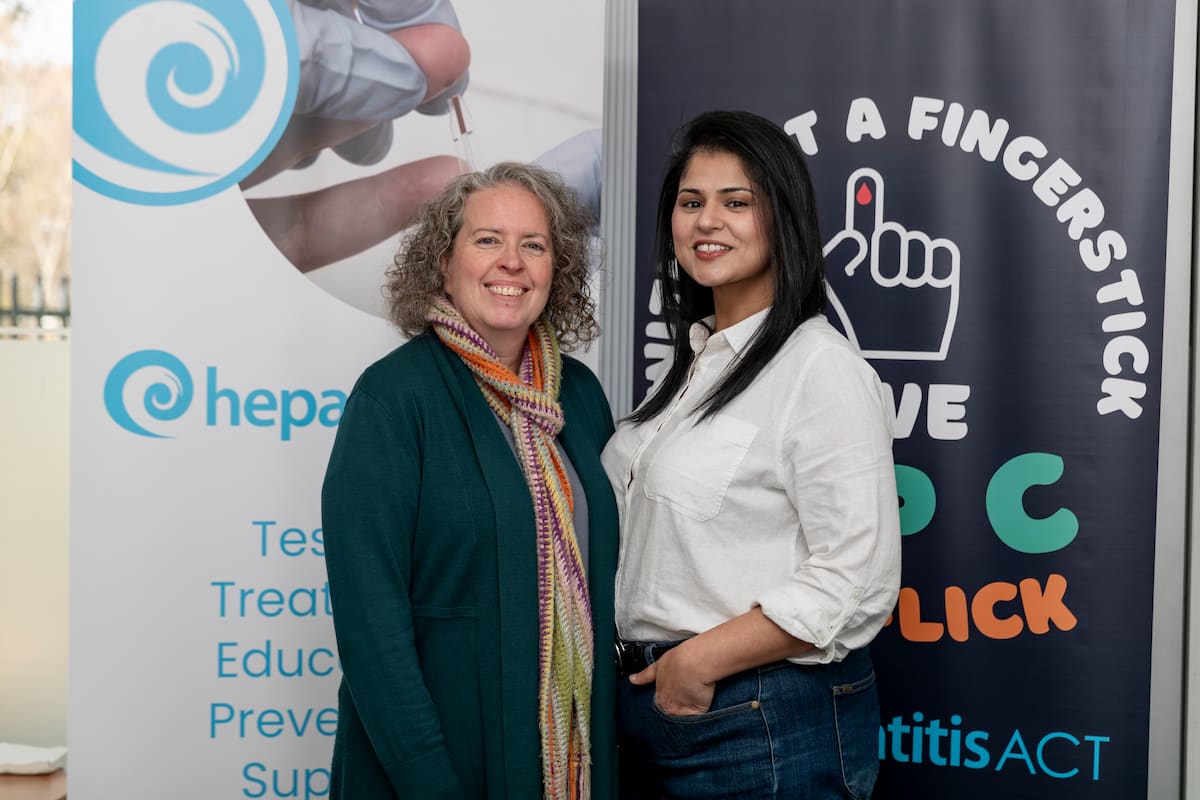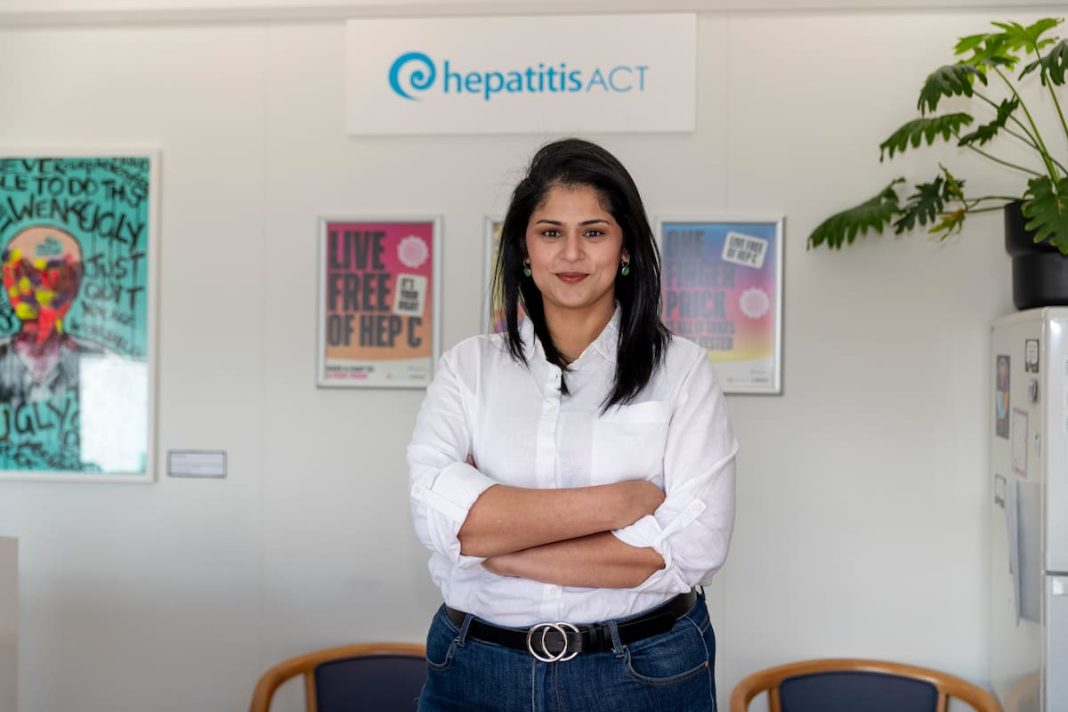Almost 300,000 Australians have viral hepatitis, a potentially fatal infection of the liver – but two-thirds of infected people are unaware they are infected. Ahead of World Hepatitis Day (28 July), Hepatitis ACT, Canberra’s community hepatitis organisation, is urging the public to get tested.
“[Hepatitis B] is quite an insidious virus,” Executive Director Sarah Ahmed said. “Our liver is such a beautiful, resilient organ that a lot of people are living with the virus, but there are really no symptoms until the disease is quite progressed.”
Untreated, viral hepatitis can lead to chronic liver disease, cirrhosis, or liver cancer, the fastest growing cause of cancer death in Australia.
“When you have a cold or flu, you’re sneezing, you’re coughing, you feel awful – but hepatitis … just lives in you and slowly works through your liver, destroying it until it gets really bad,” Ms Ahmed said.
More than 4,500 people in the ACT have hepatitis B or hepatitis C, the two most common hepatitis viruses.
Hepatitis B is the most prevalent blood-borne illness in the ACT; nearly 3,000 Canberrans are living with it, but an estimated 70 per cent of them have not been diagnosed. Worryingly, hepatitis B deaths increased by 5 per cent between 2017 and 2022.
Similarly, one in five people with hepatitis C, the second most prevalent hepatitis virus, do not know they are infected, and a quarter of those ‘diagnosed’ have not received confirmatory testing.
Hepatitis B is most commonly transmitted from mother to child, but it is also spread by blood-to-blood or sexual contact. Hepatitis C is spread by unsafe injecting practices; unsterilised medical, dental or cosmetic procedures; and tattooing and body piercing.
Priority populations at risk include people who inject drugs (including medication and steroids); those who have been in custodial settings; those from high prevalence countries; young people; First Nations Australians; and those who have not been vaccinated.
“It’s a wide diaspora of the demographic that we are trying to assist,” Ms Ahmed said.
Viral hepatitis is not part of regular GP blood tests; patients must ask for a test to know their status.
“We are continually asking people to get tested because the only way to find out is to get tested,” Ms Ahmed said.
However, testing for hepatitis C has become much easier: no need to go to a doctor; instead, Hepatitis ACT offers free fingerstick testing.
“It’s basically a prick on your finger: you get a few drops of blood out, and then we can give you your results in about an hour,” Ms Ahmed explains.
“The fingerstick test detects antibodies, which the immune system produces against a virus”, Hepatitis ACT’s business manager Kareen Tait explains; “their presence shows that the person either has an active infection or was infected at some stage.”
“If the results are positive, another sample of blood will be analysed by a machine. An hour later, they will know the person’s viral load (the quantity of hepatitis virus present in the blood), showing whether the infection is active, and the severity of the infection.”
“The more people that are screened for hepatitis B or hepatitis C, the more they know their status, they can either choose to get vaccinated for hepatitis B or get into treatment for either virus,” Ms Ahmed said. “The problem is not knowing.”
Hepatitis B has a vaccine but no cure; hepatitis C has no vaccine, but “a very easy, very effective cure”, Ms Ahmed said.

At present, the treatment for hepatitis B involves regular monitoring by an s100 prescriber GP, who is authorised to prescribe hepatitis B and HIV medication. If needed, the GP may put the patient onto medication to lower the viral load or to suppress the virus.
“[A cure] is being worked on, but it’s still a few years away,” Ms Ahmed said. “That is why it is so important for people who have hepatitis B to get onto treatment to maintain the viral load so that the damage to their liver is minimised, and when the cure does become available, it’s not too late… We just need people to get onto an ongoing management plan to delay the damage while we wait for the cure to come through.”
Nearly 1,500 people have hepatitis C in the ACT, but only 4 per cent (59) received treatment in 2022. (The ACT Government estimates, however, that almost half of the people with hepatitis C have engaged in care.)
The low treatment rate may be due to the sheer unpleasantness of the treatment that was commonly used until a decade ago: interferon-alpha, using a protein produced by the immune system. Common side-effects included flu-like symptoms, fatigue, depression, and anaemia.
Since 2016, however, direct-acting antivirals have been used; they target the virus, inhibiting proteins it needs to replicate. The regimen takes two to three months; side-effects are negligible; and the cure rate is 97 per cent.
“The problem is that some people have been so traumatised by the experiences of others (pre-DAA, pre-2016) that they find it difficult to believe that now there is such an easy and efficient cure,” Ms Ahmed said.
“Treatment has changed. The cure is really easy, efficient, and effective. And Hepatitis ACT is there to walk on that treatment journey with you.
“There is no reason why anyone should be dealing with hepatitis C in this day and age. There is a cure. Let’s get it over and done with as soon as possible.”
“The theme of this year’s World Hepatitis Day is “It’s Time to Take Action”. The World Health Organization intends to end viral hepatitis by 2030, and both the Australian and the ACT Governments are working towards that goal”, Emma Davidson, ACT Minister for Population Health, said. The national hepatitis B and C strategies, soon to be released, will underpin that work.
“2030 is fast approaching,” Ms Ahmed says. “It’s a ticking clock that we are always mindful of.”
But Ms Ahmed believes that the elimination of the virus is achievable.
“The goal is to get people tested, vaccinated for hep B and get as many people as possible into treatment for either virus. It’s doable. We just need to have a very collective impact…”
Already in the ACT, more than 97 per cent of children have been vaccinated for hepatitis B by the age of two, Ms Davidson said. “It is important that we continue to promote the availability of antiviral therapies that can provide a cure for hepatitis C,” the minister added.
To raise awareness, several Canberra landmarks will be lit up in green.
A community breakfast will be held at the Pavilion on Northbourne (242 Northbourne Avenue, Dickson) from 7:30am to 9am on Monday 22 July. Community organisations, healthcare providers, and advocates will speak about the virus and the need for better care and treatment. To register, visit events.humanitix.com/world-hepatitis-day-breakfast.
Hepatitis ACT will run a campaign to raise awareness: they will send coffee cups to local cafés with a QR code leading to a webpage with information and a photo competition.
Hepatitis ACT also runs a needle and syringe program (they offer sterile needles and syringes, and dispose of used ones); education sessions; testing, vaccinations, and treatment services. They pay for the treatment if the client cannot afford them.
“We’re trying to look after people the best way we can,” Ms Ahmed said. “And the best way to do that is to provide screening facilities, treatment, vaccinations, and harm reduction.”
Hepatitis ACT
36 David Street, Turner, opposite the O’Connor shops; drop-ins welcome, Monday to Friday, 9am to 5pm. Free call 1800 437 222. www.hepatitisact.org.au



